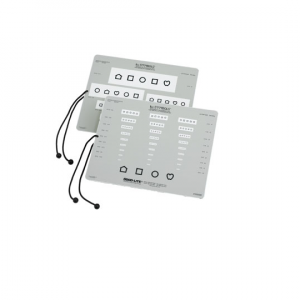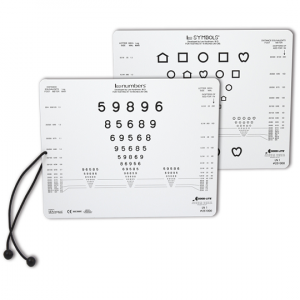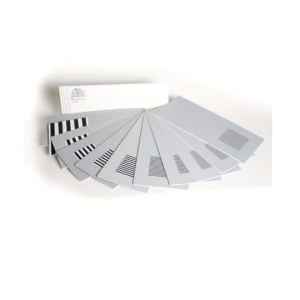Showing 1177–1193 of 1193 results
-
Near Visual Acuity Testing, Pediatric Opthalmology
HOTV Near Vision Card
This double-sided near vision card combines proportionally-spaced lines on one and 50% spaced rectangle (Massachusetts Visual Acuity Test Format) on the other. Attached 16-inch (40 cm) measuring cord ensures proper screening distance. Includes flash cards and instructions.8 in x 10 in (20.3 cm x 25.4 cm).
16-inch, 40 cm testing distance.
SKU: 731000 -
-
Near Visual Acuity Testing, Pediatric Opthalmology
Lea Symbols Massachusetts Near Vision Screener
This assessment is designed for amblyopia testing or screening. This near vision chart has 50% spaced rectangle (Massachusetts Visual Acuity Test format) with line sizes from 20/400 to 20/16 (6/120 to 6/4.8) equivalent.
16 inches, 40 cm testing distance.
SKU: 258900 -
-
Near Visual Acuity Testing, Pediatric Opthalmology
Lea Symbols and Lea Numbers Near Vision Card
This card combines a lea symbols® line test on one side and lea numbers® line test on the opposite side. Proportionally-spaced lines from sizes 20/400 to 20/10 (6/120 to 6/3) equivalent.
16 inches, 40 cm testing distance.
SKU: 251000 -
-
-
LEA Core Test, Pediatric Opthalmology
LEA 3 D Puzzle
The LEA 3-D Puzzle is designed for supporting the development of the concept of “same”, first with colors, then with black & white concrete forms that are prerequisites for the measurement of recognition acuity with the LEA SYMBOLS® tests at an early age.
SKU: 251600 -
LEA Core Test, Pediatric Opthalmology
Heidi Expressions Test Game
Some children with brain damage-related vision loss may achieve near normal results in routine vision tests (large visual field and normal or near normal visual acuity), but cannot interpret facial expressions or recognize people’s faces.
SKU: 254505 -
Near Vision Chart, Ophthalmic Clinical Research
Colenbrander Reading Card Low Vision and Mixed Contrast English
 Near Vision Chart, Ophthalmic Clinical Research
Near Vision Chart, Ophthalmic Clinical ResearchColenbrander Reading Card Low Vision and Mixed Contrast English
Continuous text cards simulate everyday tasks and activities that patients may encounter, such as reading the newspaper.
Designed as a simple screen test. The usual question for a reading test is: What is the smallest (black) line you can read? On the contrast card one adds the question What is the smallest (grey) line you can read? The difference between the two measurements will be obvious and can simply be expressed in lines. Preliminary findings indicate a 2 or 3 line difference is normal.
Unrelated simple sentences at 4th grade level.
Serves as an educational tool to demonstrate the effect of contrast deficits to patients and family members.
SKU: 4061_ -
Illiminator Cabinet, Ophthalmic Clinical Research
Large LED Illuminator Cabinet 300
2425LED-300 7 Presets at 3, 10, 40, 85, 160, 320 and 800 cd/m2
This configuration allows for testing vision under several different luminance levels with optional charts in high contrast, low contrast and threshold contrast and different test distances.SKU: 2425LED-300
















